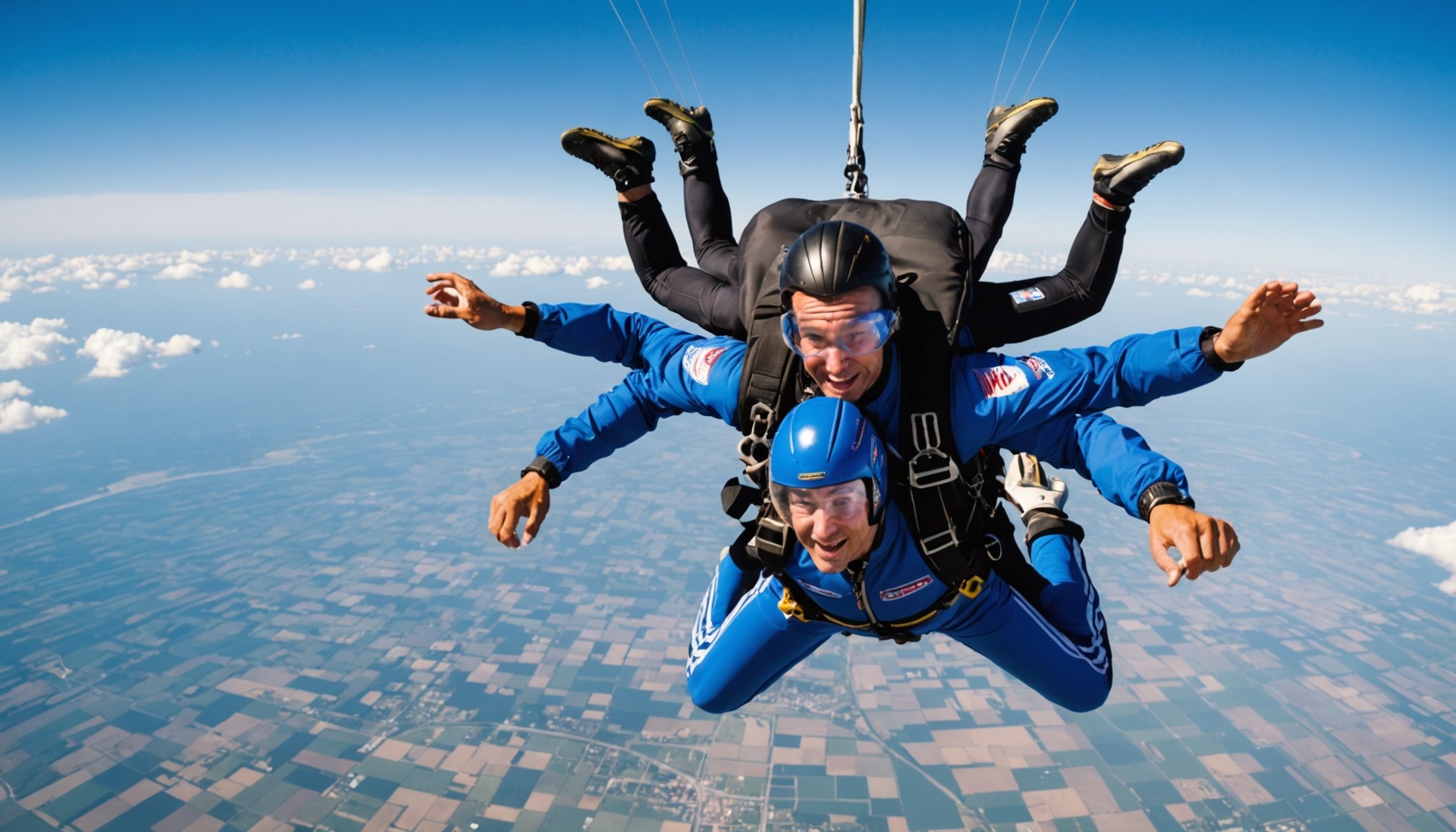Introduction to Barometric Pressure in Skydiving
Understanding barometric pressure is essential for both beginner and experienced skydivers. At its core, barometric pressure measures the weight of the air above us and plays a critical role in determining weather patterns. For skydivers, this pressure directly affects performance and altitude awareness. As you ascend, the air becomes thinner, resulting in lower barometric pressure. This transition is crucial since it affects how quickly a skydiver falls and how their equipment operates.
During a jump, altitude awareness becomes increasingly important. Skydivers rely on instruments such as altimeters to track their heights accurately, connecting altitude to changes in barometric pressure. With increasing altitude, the pressure decreases, which can impact the free fall rate and the function of parachutes. Variations in altitude and pressure are also factors in how skydivers perceive their jump and make strategic decisions.
Also read : Discover the best pistol gel blasters for every adventure
Thus, grasping the relationship between barometric pressure and altitude can significantly influence one’s skydiving performance. Being knowledgeable about pressure variations can help skydivers forecast conditions and adjust techniques, ensuring a safer and more exhilarating experience. Understanding these dynamics empowers skydivers to maximise their jump by making informed decisions.
Effects of Barometric Pressure on Altitude Perception
Altitude perception is crucial for ensuring skydiving safety. Changes in barometric pressure affect altimeter readings, which are essential tools for skydivers to accurately gauge their heights. When pressure alters, the altimeter might display inaccurate readings, leading skydivers to misjudge their altitude.
Also read : Crafting an Effective Training Program for Junior National Taekwondo Teams: A Step-by-Step Guide
This misjudgment can have significant implications during a skydive. Incorrect altitude perception can lead to deploying a parachute too early or too late, which can compromise skydiving safety. The psychological effects of perceived altitude during freefall intensify the situation, as skydivers heavily rely on their altimeters to ensure a safe and coordinated landing.
Case studies have shown instances where altitude misjudgments occurred due to abrupt pressure changes. In one notable case, a skydiver underestimated their actual altitude due to the altimeter’s pressure sensitivity and made an early descent decision. This resulted in an improper canopy deployment, which could have been avoided with accurate pressure readings.
It is vital for skydivers to understand the impact of barometric pressure effects to prevent potential altitude misjudgments. Training regimes often include simulations to adapt skydivers to these potential discrepancies, enhancing safety and confidence during freefall.
Freefall Speed Variations Due to Pressure Changes
In the world of skydiving physics, understanding how freefall dynamics change with atmospheric conditions is crucial. A key factor is pressure impact on speed. Lower air pressure, typically found at higher altitudes, reduces air resistance. This means that a skydiver can experience increased freefall speeds as they descend. The decrease in air molecules allows the skydiver to cut through the air with less friction.
To illustrate, let’s consider a data analysis comparing freefall speeds under various pressure conditions. At sea level, where pressure is higher, a skydiver may reach terminal velocity slower than at higher altitudes. Conversely, as pressure decreases, their freefall speed can dramatically increase, reaching terminal velocity more swiftly and maintaining higher speeds throughout the descent.
Experienced skydivers often share anecdotes about these changes. For instance, some describe the exhilarating rush when transitioning from high to lower pressure zones, noting that the change in freefall dynamics enhances the sensation of speed. Others recall jumps during changing weather conditions, where pressure shifts caught them by surprise, demanding quick adaptation to the varying speed. Their experiences underscore the significance of understanding skydiving physics for both thrill and safety.
Parachute Deployment and Barometric Pressure
Understanding the interplay between barometric pressure and parachute deployment is vital for ensuring safe landings. The deployment altitude is primarily influenced by air pressure, which fluctuates with weather and altitude changes. As barometric pressure decreases with elevation, parachute deployment mechanisms are calibrated to respond at precise altitudes. This precision is crucial; a misjudgment can result in premature or delayed deployments, both of which risk safety.
In terms of design, parachutes are engineered to adapt to various pressure effects. The material and rigging must withstand high air resistance, channeling just the right amount of air to open safely and predictably. High-performance parachutes often feature vents or unique fabric compositions to handle different pressure scenarios.
For skydivers, adapting to varying barometric conditions requires not just understanding their parachutes but also monitoring environmental factors like weather forecasts. Training includes scenarios with diverse pressure profiles, preparing them to execute deployments efficiently. It’s recommended for skydivers to continuously refine their skills through practice under different atmospheric conditions, ensuring they are prepared for any pressure fluctuation during actual jumps. This preparedness is not merely precautionary but a necessity for optimal safety.
Strategies for Skydivers to Adapt to Pressure Variations
When it comes to skydiving, coping with pressure changes effectively can significantly impact performance. For seasoned professionals and newcomers alike, strategically addressing these variations can make a noticeable difference.
One key aspect is incorporating practical tips for on-site adjustments. Skydivers can use current pressure readings to make informed choices about their gear and timing. For example, adjusting the parachute’s pull timing based on altitude pressure changes can enhance safety.
Pre-jump preparation techniques play a crucial role in managing these uncertainties. Breathing exercises, for instance, can help skydivers remain calm and focused, reducing the physiological effects of pressure variations. Visualisation techniques are also beneficial, as they mentally prepare the diver for potential stressors.
Training is fundamental in understanding and responding to pressure variations. Regular exposure to simulated environments allows divers to become familiar with how their body and equipment react under differing conditions. This preparation fosters intuitive and confident decision-making.
In conclusion, combining on-site adaptations, diligent pre-jump preparation, and comprehensive training ensures skydivers are well-equipped to tackle the challenges posed by pressure variations, ultimately leading to an improved jump experience.
Expert Insights and Research Findings
Delving into scientific research on skydiving performance unveils fascinating insights about barometric pressure. Studies have shown that variations in barometric pressure can significantly impact a skydiver’s rate of descent and stability. Lower pressure often correlates with faster descents, affecting control and requiring adaptations in technique. Such findings are crucial for training and safety protocols, ensuring skydivers are prepared for differing atmospheric conditions.
Interviews with experienced skydiving instructors reveal that they often utilise this research to tailor training sessions. For example, instructors may advise skydivers to adjust their body positions during jumps when anticipating low-pressure environments to maintain stability.
Meteorologists, experts in atmospheric conditions, contribute significantly by providing insights into upcoming weather patterns that might influence jumps. Their expertise allows the planning of jumps when conditions are ideal, minimising risks associated with unpredictable barometric fluctuations.
Moreover, understanding skydiving performance metrics through data-rich studies offers a roadmap for enhancing safety measures. These metrics, derived from expert opinions and research, guide the implementation of protocols that adjust for atmospheric changes, enhancing both training efficacy and overall safety.
Visual Aids and Data Analysis
When it comes to understanding the intricate dynamics of skydiving data, visual aids like charts and graphs play a pivotal role. They simplify complex information and make connections between pressure impacts and performance more comprehensible. For instance, a well-crafted graph illustrating the relationship between air pressure and jumper stability can quickly highlight critical correlations.
Consider a chart that plots pressure against skydiver’s descent rate. It allows us to visually grasp how changes in atmospheric pressure can influence the overall performance metrics during a dive. Such insights are invaluable for both novices seeking to refine their skills and seasoned skydivers aiming to optimize their performance.
Data analysis doesn’t end with just visual interpretations. Delving deeper, these visual representations help identify trends within the skydiving community. For example, by collecting extensive skydiving data, one might notice performance patterns that vary with seasonal pressure changes. These trends provide a solid foundation for making informed decisions, whether it’s tailoring training programs or modifying equipment for enhanced safety.
Utilizing these tools and analyses, enthusiasts and professionals alike can improve mastery over their craft, ensuring each jump is as effective and thrilling as the last.











